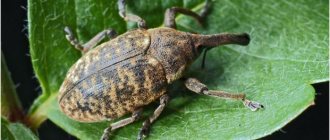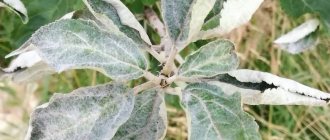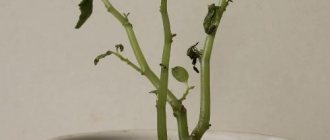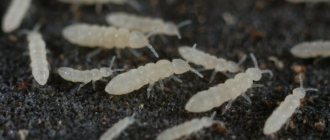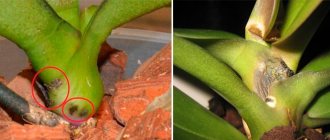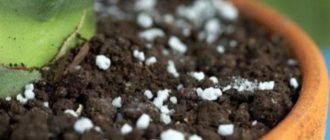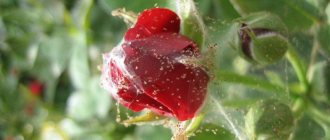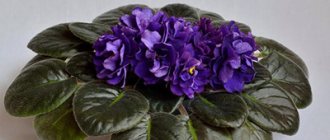Author: Elena N. https://floristics.info/ru/index.php?option=com_contact&view=contact&id=19 Category: Plant Diseases Published: November 13, 2017Last edits: July 21, 2020
- Black spot of tomatoes
- Black spot on grapes
- Black spot on roses
Symptoms of black spot on different plants are caused by different pathogens. For example, black spots on the leaves of roses are caused by the fungus Marssonina rosae, and black spots on lilacs are caused by bacteria of the genus Syringae. In our article, we will try to describe in detail what causes and how diseases with such symptoms occur on different plants, and will also tell you how to protect your garden from this disease.
Black spot disease - description
Black spotting appears as dark brown, almost black spots with a light center or, conversely, light edges. Round or oblong swellings may form on the spots. Signs of the disease usually appear in early summer. With its rapid development, the disease covers large areas of leaf tissue, as a result, the leaves turn prematurely yellow and fall off, the branches become bare, the plants weaken and develop poorly, bloom and bear fruit. The infection is spread by wind, water and insects. Black spot progresses during periods of prolonged rains against the background of low temperatures and a deficiency of potassium in the soil. The cause of the disease can be mechanical damage to the bark or leaves of the plant.
Errors in care as a reason
Often the occurrence of orchid disease is explained by improper care .
Sun or heat burns.
Such damage to orchid leaves most often occurs due to:
- exposure to direct sunlight ;
- heat from heating radiators in winter;
- flow of hot air from the air conditioner.
This orchid condition is not a disease and therefore cannot be treated.
Insufficient lighting, low temperature, waterlogging.
A complex of unfavorable factors provoke yellowing and wilting of leaves , as well as blackening of the leaf blade due to:
- excess moisture as a result of frequent watering;
- insufficient or weak lighting ;
- hypothermia of the flower.
With short-term freezing, the orchid still has a chance to survive, but if it spent more than 11 hours in the cold , it will most likely die.
Black spot treatment
Measures to combat black spotting
First of all, you need to be sure that you are dealing with black spot, and there are two options: if you find symptoms of this disease on a rose, then you will have to fight a fungus, and if on a tomato or pepper, then it is bacterial black spot. spotting. However, there are methods of control that are common to diseases of any nature and are aimed primarily at improving plant health. That is, there are a number of measures that simply do not allow the infection to develop on the plant.
Black spotting - prevention
First of all, you need to take a responsible approach to choosing the place where you are going to grow this or that crop. This means that light-loving plants do not need to be planted in the shade and, conversely, shade-loving crops cannot be grown in full sun: this weakens the plants and makes them susceptible to infections. The quality of the soil is also of great importance: you must adapt the soil on the site as much as possible to the requirements of the crop being grown. When choosing plant varieties, give preference to those that are resistant to diseases and pests. It is also important that these varieties are adapted to the conditions of your region. Disinfect seed material, especially if it came to you from a little-known source. Plant plants within the time limits recommended by professionals according to developed schemes, comply with the necessary agrotechnical conditions, regularly carry out preventive treatments of plants against diseases and pests, maintain a balance in fertilizing and soil moisture. After harvesting, do not forget to remove plant debris from the site and tidy up the soil.
- Orchid roots are rotting and drying out - what to do?
What to do if black spots appear at the base of the leaf?
Most often, their occurrence is associated with infection of the plant by phytopathogens , and not due to ordinary rotting from stagnant water:
- to prevent the spread of the disease, the damaged area is removed , partially capturing healthy green tissue;
- sections are disinfected with iodine , brilliant green, and crushed charcoal.
To eliminate stagnant water that accumulates in the axils of the leaves after watering, remove it with a paper napkin .
Black spotting of plants (garden)
Black spot of tomatoes
The causative agent of bacterial black spot, which affects tomatoes both outdoors and indoors, is the gram-negative rod-shaped bacterium Xanthomonas vesicatoria. Watery pinpoint spots form on the leaves of seedlings and young plants, increasing in size to 1-2 mm, and the edges of these spots gradually turn yellow. On adult plants, the spots are located mainly along the edges of the leaves, as well as on the petioles and stems. Bacterial spotting also appears on tomato fruits in the form of dark convex dots with a watery border, increasing to 6-8 mm and turning into sores. The causative agent of the disease can survive on seed and plant debris, which is why it is so important to treat tomato seeds before sowing for seedlings.
The bacterium can penetrate into the ground organs of the plant through cracks, breaks, or any mechanical damage. It quickly spreads through tissues: from the moment of infection until the first signs appear, 3-5 days pass; on fruits, symptoms of spotting appear later, and the infection spreads to neighboring plants within two weeks. Air temperatures above 25 ºC contribute to the development of the disease, and at lower temperatures the disease only slows down its development, but does not go away. Another condition for the rapid development of bacterial spotting is increased air humidity to 70-75% and direct contact of moisture with the ground organs of the plant. Under such conditions, black bacterial spot develops rapidly on tomatoes.
Tomato diseases and their treatment
The bacterial pathogen persists as long as there is a food source, but on cleanly harvested soil after harvest it dies within 4-5 weeks.
It must be said that scientists have not yet developed tomato varieties that are resistant to bacteriological spot, but tomatoes that are not susceptible to fungal diseases also offer decent resistance to black spot. In the fight against the bacterium, preventive measures are of paramount importance, for example, treating seeds before sowing. This can be done in the following ways:
- keep the seeds for one hour in the fungicide solution;
- treat the seeds for half an hour in a pink solution of potassium permanganate;
- dissolve 12 g of Trisodium Phosphate in 100 g of water and dip the seeds into the solution for 1 hour, then rinse them very thoroughly in a sieve or under running water for 20-30 minutes;
- hold the seed for 20 minutes in water at a temperature of 60 ºC.
Using these simple methods, you can destroy the infection located on the surface of the seeds, but you need to fight the internal seed infection differently: before sowing, soak the seeds for 6 hours in a one percent solution of the biofungicide Planriz.
Before planting in the ground, tomato seedlings are also treated twice with Planriz, Fitosporin-M, Gamair or Baktofit. Fitolavin is very effective on tomatoes, which destroys not only the causative agents of bacterial spot, but also bacterial cancer, blossom end rot and other diseases of nightshade crops.
- Orchid roots are rotting and drying out - what to do?
Subsequently, growing tomato bushes are treated from time to time for preventive purposes with copper-containing preparations: a one-percent solution of Bordeaux mixture, Oksikhom, Khom and other fungicides of similar action.
Black spot of pepper
Sweet peppers are parasitized by the same bacterium as tomatoes: Xanthomonas vesicatoria. Most often, it affects young organs, forming watery pinpoint spots on stems, leaves, cotyledons, fruits and petioles, which turn black over time and acquire an angular or rounded shape. These black spots, surrounded by a yellowish border, reach 1-2 mm in size. The spots spread along the veins of the leaves, and light yellow necrosis with dark edges forms in their center. Black convex dots, surrounded by a watery border, also first appear on the fruits. They gradually increase to 6-8 mm and turn into rotting sores.
Both preventive and therapeutic measures to combat the causative agent of bacterial black spot on peppers are absolutely the same as on tomatoes.
Signs of thrips damage
These pests affect almost all indoor plants. They can be especially often found on monstera, indoor lemon, dracaena, all palm trees, laurel trees, indoor roses, and orchids. First of all, this is the appearance of the harmful insects themselves. Adult thrips can be seen with the naked eye. They look like black dots on the surface of the leaf. For a detailed examination, as well as detection of larvae and egg clutches, it is better to arm yourself with a magnifying glass. Damage to the plant is indicated by the appearance of small colorless or slightly yellow spots on the leaves. As the affected area increases, these spots take the form of streaks and subsequently merge into solid whitish spots. In some cases, a heavily damaged sheet acquires a metallic tint with brown spots on the inside. The result is that the leaf dies. Another characteristic characteristic of plant infestation by thrips is the appearance of sticky honeydew, which is a waste product of the pest. It also poses a certain danger, as it contributes to the appearance of an unpleasant disease - “sooty fungus”.
- print version
- 1
Treatment of black spot on fruit and berry crops
Black spot on grapes
Grape black spot, or escoriosis, or phomopsis, or shoot dieback, or bark cracking, or dry sleeve, is caused by the fungus Phomopsis viticola. It appears in June on the nodes of annual shoots as black-brown or black dots of round or oval shape - swellings of tissue with a focus of necrotic cells in the center. As escoriosis develops, the number of dots increases and they begin to merge into spots that open in the middle. The darker edges become covered with cork tissue and look like scabs. Spotting usually affects the first 6-7 internodes of the shoot. The lowest leaves, tendrils, cluster ridges and even flowers are infected. Leaf necrosis is surrounded by a light, dense border; tissue tension causes the leaf plate to become curled, rupture, and holes appear. Leaves turn yellow prematurely. Due to deformation and tearing of leaves, photosynthesis is weakened, and more than half of the buds in the lower internodes of annual shoots may die. Blackspot-affected berries turn dark purple and have an unpleasant taste, and annual wood turns whitish-gray.
The pathogen spreads with dew, rain, wind, insects and penetrates the plant through mechanical damage and stomata. Black spot reduces the winter hardiness of grapes, and if it is not dealt with, the disease will destroy the plant in 5-6 years.
When growing grapes, you should give preference to varieties that are resistant to black spot. The most famous among them are Cabernet Sauvignon, Lyana, Traminer, Tavrida, Iskra, Riesling, Bastardo Magarachsky, Relay. If the disease has already affected your grapes, begin treatment immediately, however, due to the fact that the mycelium of the fungus is deep in the tissues, attempts to destroy black spot with fungicides will be ineffective, but treating grapes with chemicals DNOC or Nitrafen can affect fruiting bodies and spores. And if you regularly carry out preventive treatments against fungal diseases, then black spotting will bypass your grapes.
During the growing season, as a preventive measure, grapes are sprayed with one percent Bordeaux mixture or the preparations Euparen, Efal, Mikal, and these treatments must be started even earlier than prevention against anthracnose and mildew: the grapes are sprayed for the first time when the buds swell on them, and after 4-5 leaves will appear on the shoots, carry out the second treatment. The third time the grapes are sprayed after they have flowered, and it is advisable to use a product that is effective not only against black spot, but also destroys the pathogens of powdery mildew and peronospora.
- Orchid roots are rotting and drying out - what to do?
In late autumn, if the grapes are severely affected by black spot, after pruning or defoliation, they are sprayed with a copper-containing preparation so abundantly that the bushes are literally washed with a medicinal solution. Sleeves showing signs of drying should be removed. Fungicides Maxim, Captan, Mancozeb and Triadimenol have proven themselves to be effective against black spotting on grapes. To avoid infection, the following preventive measures should be taken:
- plant only healthy vines;
- regularly inspect the vineyard, monitor the health of the plants;
- immediately after detecting signs of the disease, remove and burn the affected areas of the plant;
- tie up shoots, not allowing them to lie on the ground;
- feed the grapes with a balanced fertilizer, which should include microelements such as zinc and boron.
Since black fungal spot is a chronic disease, be prepared for a long battle. But even if you destroy all infectious agents in your vineyard, preventive work must be continued.
Preventive measures
To prevent the development and occurrence of various diseases, the following measures must be taken:
- Visual inspection of plants 1-2 times a week to identify primary signs of disease.
- Compliance with the norm of daylight hours and light levels for each type of plant. At the same time, excess lighting is just as undesirable as its lack.
- Maintaining temperature conditions. It also includes avoiding significant temperature fluctuations during the day, avoiding cold drafts and overheating of the soil in pots when placing flowers on window sills above heating radiators.
- Timely watering of flowers - preventing the soil from drying out or being overly moistened.
- Ventilate the room and maintain the required humidity.
- Isolation of infected plants from healthy ones when the first signs of the disease are detected.
It is easier to prevent every disease than to fight its manifestations. Proper care of the plant will help protect it from diseases and parasites.
Black spot on flowers
Black spot on roses
Black spot of roses is caused by the fungus Marssonina rosae, which attacks the leaves and green shoots of the plant. On the upper side of the rose leaves, red-white and then black rounded radiant spots appear, as if bordered by a fringe. The lesion begins with the lower leaves, but the disease quickly covers the entire bush. Diseased leaves become gray-brown, curl, die and fall off, the rose weakens, forms fewer buds or refuses to bloom at all. If the damage is severe, some bushes may even be left without leaves by autumn.
As soon as you see signs of disease, remove diseased leaves from and under the bush. How to deal with black spot on roses? Every 7-12 days, treat the bushes with a solution of a fungicide - Abiga-Pika, Bordeaux mixture, Previcur, Skor, Topaz, Fundazol, Mancozeb, Thiophanate-methyl or Trifloxystrobin, and spill the soil around the bush 2-3 times with a solution of Fitosporin-M. In the fall, before covering the rose for the winter, collect all the leaves from the bush and from under it and burn them, and treat the bare bush with a three percent solution of iron sulfate. In the spring, before the start of the growing season, trim the shoots and branches of the rose to healthy wood, then treat the bush and the soil under it with one of the listed preparations.
Planting and caring for roses in the garden
Black spot (marsonina) can be confused with diseases such as brown spot, peronospora, phyllosticosis, cercospora, septoria, purple spot, ascochyta and sphacelloma. However, if there is confusion in diagnosis, do not be discouraged: all these diseases are treated with fungicides.
Where does the parasite prefer to hide?
Since thrips prefers not to be seen, you can get rid of it only by taking the initiative into your own hands. At the first suspicion of a disease, inspect the leaves of the plants for the presence of black spots on the underside. This is how thrips lay larvae.
Thrips on a plant
Parasites are sensitive to vibrations, and if the plant is slightly shaken, thrips will hasten to hide in the leaf axils and inside the flowers. Before you shake the plant, place a white sheet underneath it. If your flower is infested with insects, some of the pests will fall out, and on a light surface it will be easier for you to see them so that you know what you have to fight.
Thrips larvae live and feed on anthers. This causes pollen to be shaken off onto the leaves. To verify the presence of the parasite, you need to open the anther. This is where the harmful larvae gather.
Preparations for black spot (fungicides)
When choosing drugs against a particular disease, you should have at least an approximate idea of their action and purpose. We offer you a list of fungicides that will help you fight not only black spot, but also other fungal diseases.
- Abiga-Pik is a copper-containing broad-spectrum contact fungicide designed to combat fungal and bacterial diseases;
- Baktofit is a biological preparation for combating bacterial and fungal diseases;
- Bordeaux mixture is a broad-spectrum contact fungicide for protecting vegetables, fruits, berries, melons and other crops from fungal diseases;
- Gamair is a biological bactericide for suppressing certain fungal and bacterial diseases on plants and in soil;
- Captan is a contact fungicide with a multi-vector mechanism of action on fungal organisms;
- Maxim is a contact fungicide for treating planting material;
- Mancozeb is a protective contact fungicide to combat fungal diseases;
- Nitrafen is a complex fungicide with insecticidal, bactericidal and fungicidal properties;
- Oxychom is a broad-spectrum systemic contact fungicide for the control of fungi;
- Planriz is a microbiological preparation with bactericidal and insecto-fungicidal action to protect plants from a variety of diseases;
- Previkur is a fungicide with systemic properties that has protective and growth-stimulating properties;
- Skor is a systemic fungicide with a long-term preventive and pronounced therapeutic effect to combat fungal diseases;
- Thiophanate-methyl is a contact and systemic pesticide, fungicide and protective insecticide;
- Topaz is a systemic drug to combat many fungal diseases;
- Triadimenol is a systemic fungicide used to treat vegetative plants against many diseases;
- Trifloxystrobin is a powerful systemic and contact fungicide that has a protective, therapeutic and prophylactic effect in the fight against plant diseases;
- Fitolavin is a systemic biological bactericide for the treatment and prevention of many fungal and bacterial diseases;
- Fitosporin-M is a biological fungicide of contact action, a microbiological preparation for protecting plants from a complex of fungal and bacterial diseases;
- Fundazol is a disinfectant and fungicide with a wide spectrum of systemic action against a large number of fungal diseases;
- Hom is a fungicide of systemic-local and contact action to combat plant diseases;
- Euparen is a protective fungicide of contact action that destroys condial sporulation;
- Efal is a systemic fungicide with protective action for vegetable and fruit crops against various diseases.
Pests of indoor plants with photos and names
All plants, no matter where they are grown, are subject to invasion by various pests. In addition, indoor plants that housewives love to grow are susceptible to various diseases and the harmful effects of various insects. Various reasons contribute to this. Often housewives themselves are to blame for this, since they do not create the proper conditions for growth and development for plants. Some of them simply forget to water the plants, and some of them water them excessively. It should be noted that there are quite dangerous pests that can reduce a person’s work to zero.
As a result of the appearance of pests, indoor plants lag behind in development and lose their attractiveness, and often even die. Therefore, the main task of indoor plant lovers is the timely detection of parasites and subsequent control of them. This article talks about the main pests of indoor plants, their appearance, as well as ways to combat them.
Folk remedies to combat black spotting
Folk remedies are used differently to treat plants from black spot than for preventive treatments.
A proven preventative agent is iodine: 1 ml of iodine is diluted in 400 ml of water and this solution is used to treat plants.
One part of mullein is poured with 10 parts of water, infused for several days and poured over the rose bush in early spring after removing the cover. Such procedures are carried out from May to July 2-3 more times.
30-40 g of onion or garlic peels are boiled, left for 6-8 hours, filtered and used to treat rose bushes and the soil around them. A flowering bush should be watered with this mixture at the root, since if the decoction gets on the flowers, the petals may be stained.
Folk remedies such as herbal infusions (horsetail, nettle or other herbs) or a decoction of citrus fruits turned out to be ineffective in the fight against black spotting.
Don't forget about prevention
To prevent the appearance of thrips, it is important not to forget about preventive measures. Parasites can enter your home even with an ordinary bouquet brought from the street. Therefore, it is so important to create conditions in which pests lose their viability. First of all, there is sufficient humidity and cool air.
Each new plant purchased at a flower shop must be quarantined at home for 2-3 weeks. The soil in the pot needs to be changed or disinfected by heating it in the oven or freezing it for a day. Plants that tolerate cold water well benefit from a shower once a month.
Whitefly
This is an insect with a body length of no more than 2 mm. A characteristic feature is white wings and a yellowish body. They can be found:
- On the back side of the leaves, where they are located in colonies.
- According to characteristic sweetish traces, on which after some time a sooty fungus appears.
Whitefly larvae have a sucking type of mouthparts, so they suck out the juices from the plant. As a result, the plant loses its vitality and gradually loses its attractiveness. If no measures are taken, the plant will soon die.
Interesting fact! When appearing in greenhouses, the whitefly prefers plants such as hibiscus, pelargonium or begonia. After the appearance of just one individual, after a short period of time a whole colony of these insatiable pests appears in the greenhouse. In this regard, the fight should begin immediately.
These are also harmful insects that suck juices from plants due to the presence of piercing-sucking mouthparts. Insects have an ovoid body shape, no more than 2 mm in length. Aphids have rather long legs, but they move rather slowly. The color of insects depends on the species, as well as on living conditions, so it can be varied.
There are both winged and wingless types of insects. Naturally, insects with wings can easily enter a person’s home, even through an open window.
Root mealybug
This type of pest poses the main threat to the root system of plants. The parasite can be detected either in the ground or on the lower part of the plant stems, by a whitish coating. Females reach a length of up to 2.5 mm, while they are larger than males and much more mobile. Pests are distinguished by their almost cylindrical body shape, covered with a waxy coating. Females lay eggs in special chambers formed by special secretions.
Males are more like whiteflies. As adults, they quickly die because they stop feeding. Therefore, females make up the main population of these pest colonies.
It is important to know! The presence of such insects on indoor plants leads to the fact that the plants lose their attractive appearance. In addition, damaged plants begin to suffer from fungal diseases.

